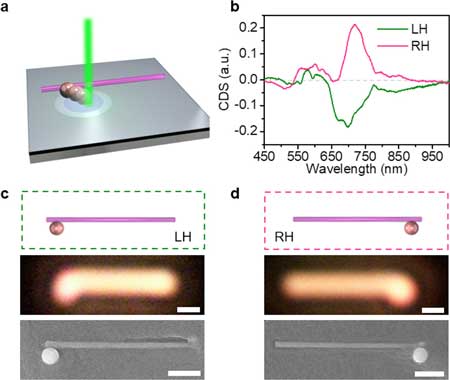| Feb 01, 2021 | |
Tunable chiral optics suitable for on-chip devices |
|
| (Nanowerk Spotlight) Chirality is a critical concept in chemistry and life sciences, especially when applied to a molecular level. Many molecules such as amino acids, proteins, sugars, and DNA are chiral. Chirality is also referred to as handedness, since hands are an everyday example of two items that – arranged in a mirror-inverted manner – cannot be superimposed onto each other. | |
| A chiral molecule is one that cannot be superimposed on its mirror image. In the same way that your left hand will not fit into a right-handed glove, many molecules will not undergo reactions that their mirror images will. | |
| Inspired by chiral molecular structures, scientists are developing strategies to build artificial chiral materials by mimicking natural molecular structures using functional materials. Specifically, metal nanomaterials exhibit tailorable optical properties upon excitation of surface plasmons and become one of the most promising components to realize chiral optical metamaterials (read more: "Bottom-up assembled chiral meta-molecules"). | |
| "The chiroptical response of chiral structures is largely determined by the arrangement of the building blocks," Yuebing Zheng, Associate Professor at the University of Texas at Austin, explains to Nanowerk. "Conventional chiral structures are static with fixed configurations and optical response, which are not suitable for applications in tunable systems and multifunctional devices. Lately, active chiral structures, where the optical chirality can be on-demand controlled, have triggered research interest for advanced applications, such as polarization conversion, biomolecular sensing, optical communication, as well as enantioselective synthesis and catalysis." | |
| Conventional chiral structures are fabricated by lithographical methods, which are expensive and involve multiple process steps. Also, most of these structures have fixed configuration and optical response. | |
| In order to assemble tunable chiral structures, researchers so far have been using solution-based techniques. However, as Zheng points out, these solution-based approaches are not suitable for on-chip devices and they suffer from undesired capillary forces as well as Brownian motion of nanoparticles, which largely limits their implementation of reliable and stable devices. | |
| Reporting their findings in Nano Letters ("Tunable Chiral Optics in All-Solid-Phase Reconfigurable Dielectric Nanostructures"), Zheng and his team now demonstrate all-solid-phase reconfigurable chiral nanostructures, where the geometry and chiroptical properties can be dynamically tailored and fully controlled on a solid substrate without liquid media. | |
| "Our work provides a simple and reliable way of fabricating tunable chiral nanostructures," notes Jingang Li, the paper's first author. "Major application areas for these chiral nanostructures are photonics – for polarization conversion and optical communication – and the biomedical field – for label-free detection of chiral molecules in diagnostics and safe medicine." | |
| He also points out that dynamic modulation of optical properties on solid substrates will significantly boost the development of on-chip active devices and solid-state microelectromechanical systems (MEMS). | |
 |
|
| Assembly of solid-phase dielectric chiral nanostructures. (a) Schematic showing the assembly of left-handed (LH; RH = right-handed) chiral structure. (b) The measured circular differential scattering (CDS) spectra of the assembled chiral nanostructures in panels c and d. (c,d) Schematic, optical, and SEM images of the assembled LH (c) and RH (d) chiral nanostructures. Scale bars: 1 µm. (Reprinted with permission by American Chemical Society) | |
| The team's chiral nanostructures consist of a silicon nanoparticle (SiNP) and a silicon nanowire (SiNW) as the building blocks, which are assembled by optothermally gated photon nudging technique (as illustrated above). | |
| To form a chiral nanostructure, the researchers optically nudge a SiNP to the vicinity of a SiNW, which breaks the mirror symmetry. By nudging the nearby SiNP along the SiNW from one end to the other, they transform the SiNP-SiNW structure from left-handed to achiral and right-handed in sequence. | |
| By tailoring the configuration of these nanostructures, their chiroptical properties can be tuned. | |
| "Going forward, we will try to optimize and enhance the chiroptical properties of these chiral nanostructures by introducing new materials and more complex configurations, and to apply them for more advanced applications in photonics and biomedical engineering," says Li. | |
| "We envision that this study will bring new insights and possibilities in various chiroptical applications, such as enantiodiscrimination and polarization conversion, for the development of safer drugs and advanced optical tools," Zheng concludes. "In addition, as a general method to construct reconfigurable nanostructures on the solid substrate, our strategy will also enable the versatile fabrication of adaptive on-chip nanodevices for a wide range of photonic and electronic applications." | |
 By
Michael
Berger
– Michael is author of three books by the Royal Society of Chemistry:
Nano-Society: Pushing the Boundaries of Technology,
Nanotechnology: The Future is Tiny, and
Nanoengineering: The Skills and Tools Making Technology Invisible
Copyright ©
Nanowerk LLC
By
Michael
Berger
– Michael is author of three books by the Royal Society of Chemistry:
Nano-Society: Pushing the Boundaries of Technology,
Nanotechnology: The Future is Tiny, and
Nanoengineering: The Skills and Tools Making Technology Invisible
Copyright ©
Nanowerk LLC
|
|
|
Become a Spotlight guest author! Join our large and growing group of guest contributors. Have you just published a scientific paper or have other exciting developments to share with the nanotechnology community? Here is how to publish on nanowerk.com. |
|
